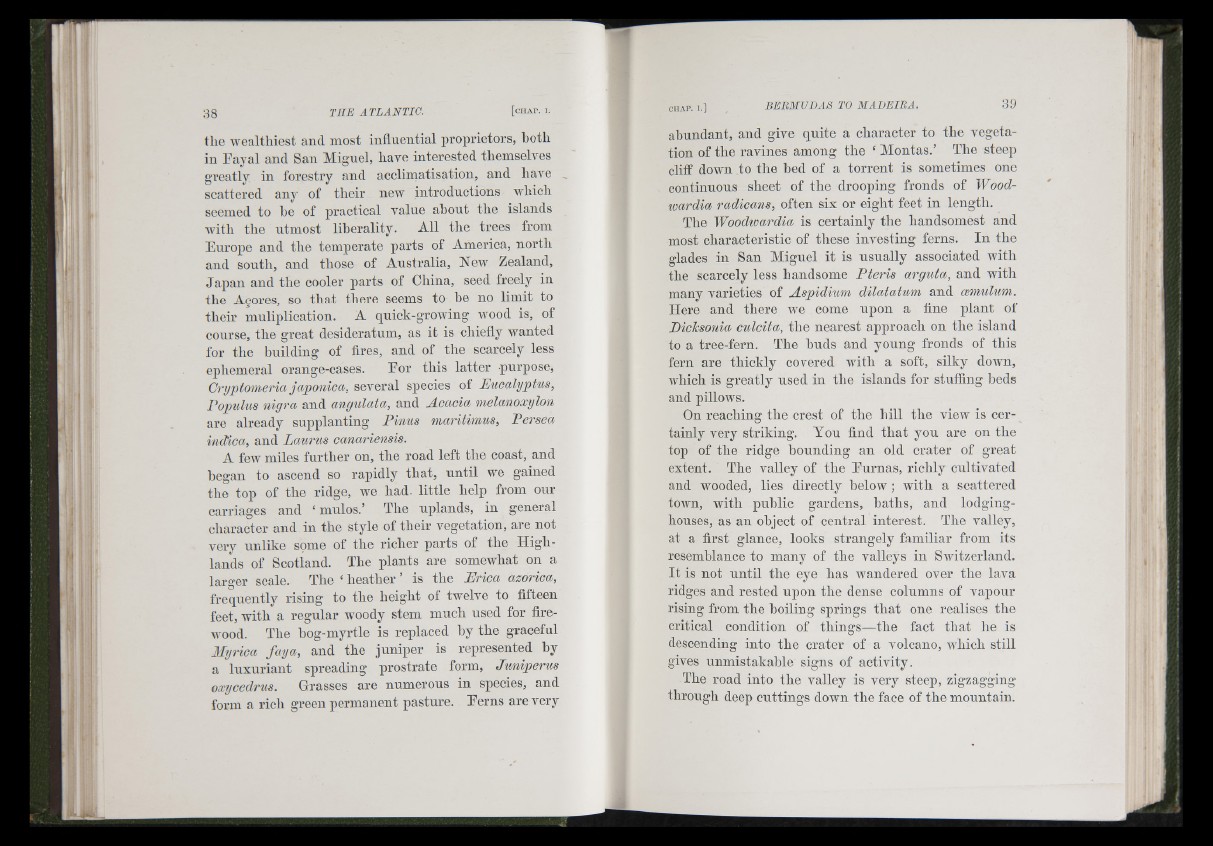
the wealthiest and most influential proprietors, both
in Fayal and San Miguel, have interested themselves
greatly in forestry and acclimatisation, and have
scattered any of their neAV introductions which
seemed to he of practical value about the islands
Avith the utmost liberality. All the trees from
Europe and the temperate parts of America, north
and south, and those of Australia, Ncav Zealand,
Japan and the cooler parts of China, seed freely in
the Açores, so that there seems to be no limit to
their muliplication. A quick-groAving Avood is, of
course, the great desideratum, as it is chiefly wanted
for the building of fires, and of the scarcely less
ephemeral orange-cases. Eor this latter -purpose,
Onjptomeria japonica, several species of Eucalyptus,
Populus nigra and angulata, and Acacia melanoxylon
are already supplanting Pinus maritimus, Persea
incUca, and Laurus canariensis.
A foAV miles further on, the road left the coast, and
began to ascend so rapidly that, until we gained
the top of the ridge, we had. little help from our
carriages and ‘ mnlos.’ The uplands, in general
character and in the style of their vegetation, are not
very unlike some of the richer parts of the Highlands
of Scotland. The plants are somewhat on a
larger scale. The ‘ heather’ is the Erica azorica,
frequently rising to the height of twelve to fifteen
feet, with a regular woody stem mnch used for iire-
Avood. The bog-myrtle is replaced hy the graceful
Myrica fa y a, and the juniper is represented by
a luxuriant spreading prostrate form, Jimiperus
oxyceclrus. Grasses are numerous in species, and
form a rich green permanent pasture. Ferns are very
abundant, and give quite a character to the vegetation
of the ravines among the ‘ Montas.’ The steep
cliff down to the bed of a torrent is sometimes one
continuous sheet of the drooping fronds of Wood-
wardia radicans, often six or eight feet in length.
The Woodwardia is certainly the handsomest and
most characteristic of these investing ferns. In the
glades in San Miguel it is usually associated with
the scarcely less handsome Pteris arguta, and with
many varieties of Aspidium dilatatum and cemulum.
Here and there we come upon a fine plant of
Dichsonia cwlcita, the nearest approach on the island
to a tree-fern. The buds and young fronds of this
fern are thickly covered with a soft, silky down,
AAdiich is greatly used in the islands for stuffing beds
and pillows.
On reaching the crest of the hill the view is certainly
very striking. You find that you are on the
top of the ridge hounding an old crater of great
extent. The valley of the Eurnas, richly cultivated
and wooded, lies directly below ; with a scattered
town, with public gardens, baths, and lodging-
houses, as an object of central interest. The valley,
at a first glance, looks strangely familiar from its
resemblance to many of the valleys in Switzerland.
It is not until the eye has Avandered over the lava
ridges and rested upon the dense columns of vapour
rising from the boiling springs that one realises the
critical condition of things—the fact that he is
descending into the crater of a Amlcano, AAdiich still
gives unmistakable signs of activity.
The road into the valley is very steep, zigzagging
through deep cuttings down the face of the mountain.